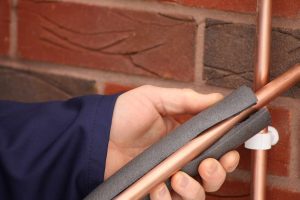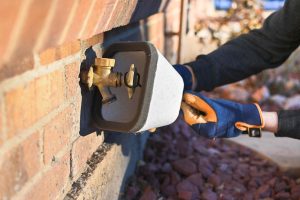You don’t need to be overly critical to be annoyed by that spaghetti-like mass of wires at the base of your wall-mounted TV. After all, you love your flatscreen TV for its slim lines that let room design take precedence, and unruly TV wires only detract from that.
Safety Considerations
Surface-mount channels and raceways cannot be used for hiding household current building wire. Plastic-sheathed NM or metal-sheathed BX electrical wiring should be installed within walls for protection. Individual strand THHN wires should be installed in rigid metal conduits. THHN, NM, and BX wiring cannot be installed in exposed locations.
Power supply cords that are hardwired to TVs and other electronic devices generally can be installed in surface-mount channels and raceways. Before doing so, always check with the device’s safety instructions.
Ethernet cords, data cables, speaker wires, coaxial, HDMI, and other wires that carry low or no voltage can be run through channels and raceways or left exposed.
Ways to Hide TV Wires
Group Wires in a Flexible Zippered Cable Manager
All wires combine to become one, organizationally speaking, when you zip them into a flexible fabric cable manager. These braided sleeves fit up to seven wires and keep them compact and tidy.
Available in several colors that blend with the wall or disappear into the dark, zippered cable managers are about two feet long each but can be lined up, one after the other, for as long as you want.
Tuck Away Wires in a Cable Management Box
That power strip on the floor is the source of so many visual woes, since multiple power cords lead out of it. It’s a cord traffic jam that seems to attract cobwebs and floor detritus like a magnet.
Made of sturdy ABS plastic, a cable management box neatly hides the power strip and excess wires in a container that looks like it absolutely belongs there. Typical colors are off-white, white, black, wood tone, and more. Some can even be painted.
Side cable ports can be opened or closed as needed. Most boxes have air holes or slots to permit discreet ventilation.
Bundle TV Wires With DIY Cable Ties
A little goes a long way with cable ties. If you’re not ready for more robust wire-hiding solutions just yet, individual cable ties spaced every foot or so wrestle a thick mass of wires into a slimmer bundle.
You don’t need special cable ties, either, Simply buy a roll of black 3/4-inch-wide hook-and-loop tape and cut off as much as you need. A 10-foot roll for less than $15 is enough to pull together as many TV wires as you need.
Replace TV Wires With Shorter Wires
Overly long TV wires that snake around the floor can be hard to minimize—even with cable management boxes and ties. The solution is to replace the long wires with shorter wires.
Power, HDMI, coaxial, and data cables all come in various lengths—some as short as one foot. Speaker wire with bare tips can be manually cut and stripped back to length.
Move Outlet Sideways to the TV
The best way to hide a TV power cord is to locate the TV directly in front of the outlet. When you can’t bring the TV to the outlet, bring the outlet to the TV.
For hiding TV wires, it’s to your advantage that the National Electrical Code requires that no space on the wall can be more than 6 feet from an outlet (or, outlets no more than 12 feet apart).
This means that the outlet nearest to the intended TV location can be extended up to another 6 feet—short work for any licensed electrician.
When extending an outlet laterally, holes must be created between studs to later be patched with drywall, tape, and paint. In some cases, the wire might be able to be run up into the attic and down or, similarly, down into a basement and up.
Conceal TV Wires in Wall Raceways and Channels
Wires for wall-mounted TVs have quite some distance to travel upward and still remain invisible. Depending on the size of your TV and the mount height that you prefer, that distance can be anywhere from 10 to 31 inches (based on an outlet height of 12 inches). For this problem, wall raceways and channels come to the rescue.
Raceways and channels are flat or D-shaped tubes that run along the surface of the wall to hide TV wires. Usually, a back strip screws into the drywall with anchors or sticks with self-adhesive. After you tuck in the cords, a decorative plate clicks into place over the back piece.
Wall raceways and channels are made of plastic in neutral, wall-camouflaging colors. Most can be painted to match the wall color.
Move TV Wires Directly Up
If you’re lucky enough to have a TV located right above an outlet, it’s easy to relocate the outlet higher. That’s because the TV wires can travel between two studs—no need to drill holes into studs to run the wire horizontally.
It also helps that an old-work or retrofit plastic electrical box allows you to place that higher outlet in the drywall, without having to nail it to the studs.
Best of all, no drywall patching is required. It’s easy to fish wire vertically through open stud bays. The lower outlet can stay in place, supplying electricity for other devices.
Other TV wires cannot be included in these outlet receptacles. But, in a separate installation, you can bring the wires up through the same stud bay.
At the top, you can cover the receptacle with a dedicated plate for a smooth look. For example, you can have combination HDMI and Ethernet terminals, or HDMI and coaxial terminals. If you’re not sure yet, just add a brush wall plate to bring wires through.
Run TV Wires Through Baseboard Quarter-Round Channel
Raceways and channels move TV wires along a wall—vertically. But what about moving them a few feet horizontally? A clever device that’s difficult to detect is a baseboard quarter-round replacement channel.
Many homes already have a type of long, narrow trim called quarter-round. It has nothing to do with wiring. It’s a piece made of solid wood or PVC that hides gaps between the wall baseboard and the flooring.
Hollow plastic quarter-round replacements, each 5 feet long and with 3/4-inch of inner space, let you run two or three wires laterally along a wall. With a top piece that snaps into an attached back piece, these quarter-round channels are easy to open and close when you need to change the wiring.
Run TV Wires Behind Crown or Wall Trim
Crown molding bridges the corner between walls and ceilings and provides a large space for running TV wires around the room.
Crown molding is difficult to cleanly remove and replace. But straight sections of existing crown molding may be able to be fished with metal electrician’s fish tape. For this, you will need to remove a section of crown molding at the end to access the space.
For thin speaker wires that need to run vertically on a wall, the back side of door trim often has a shallow channel large enough for the wire.
Conceal TV Wires in a False Wall
Brick, concrete, cinderblock, and even plaster and some drywall walls are either solid or present many obstacles to running interior TV wires.
Building a false non-load-bearing wall requires little more than two-by-fours, drywall, drywall screws, and trim. The false wall can be attached to a wall behind it. Or you can bring the false wall forward and attach it to the ceiling and floor.
With either version, adding trim to the junction between the false wall and the ceiling, floor, and adjacent walls saves you the considerable work of adding drywall compound and sanding the corners with drywall tape.
Mount Power Strip on Wall
When the power strip rests on the floor below the TV, it’s messy and looks impermanent. Simply moving the power strip off of the floor and attaching it to the wall is a quick way to de-clutter wires and make everything tidier.
Power strips’ back keyholes can be hard to figure out. If you misplace your screws by even a little, the strip won’t mount properly. Once you find out how easy it is to mount a power strip, you’ll have it up in minutes.
- Run painter’s tape across the entire back of the power strip.
- Rub your finger on the tape to locate the two keyholes.
- With a pen, poke a hole at each of the keyholes. Be sure to poke the thin part of the keyhole, not the round part.
- Pull off the painter’s tape and apply it to the wall.
- Drive screws directly through the holes in the painter’s tape, then peel off the tape.
Read the full article here









